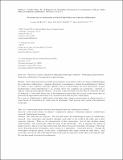Processus de co-construction et rôle de l’objet biface en recherche collaborative

Type de référence
Date
2017Langue de la référence
FrançaisEntité(s) de recherche
Université de Nantes CRENUniversité Blaise-Pascal, Clermont-Ferrand (ESPÉ) laboratoire ACTé
Résumé
Notre étude poursuit une double préoccupation. La première relève de l’aspect méthodologique des recherches collaboratives : comment chercheurs et enseignants s’initient-ils mutuellement à l’univers de l’autre, à leurs référents respectifs ? Quelles sont les caractéristiques de leurs interactions, en quoi facilitent-elles l’intercompréhension ? La seconde relève des conditions du partenariat : comment se négocie l’objet de préoccupation mutuel, c’est-à-dire ce qui deviendra à la fois objet de recherche et objet de formation ? Cette étude montre que le développement professionnel des acteurs prend racine dans un processus de négociation-conversion, et ce, au travers de la mise en jeu d’ objets biface.
En ce sens, la collaboration s’établit autour d’un même objet, chaque acteur prenant en charge une face et ayant besoin de l’expérience de l’autre pour la développer. Nous pouvons alors parler d’acculturation réciproque. Ce travail montre que la collaboration s’établit une fois qu’elle a acquis les caractéristiques d’une situation de travail dans laquelle et par laquelle l’activité de chaque catégorie d’acteurs produit du développement.
Résumé traduit en anglais
Our study has two concerns . The first falls under the methodological aspect of collaborative research : how researchers and teachers introduce each other to the world of the other and at their respective referents ? What are the characteristics of their interactions , how do they facilitate mutual understanding ? The second falls within the terms of the partnership : how to negotiate the subject of mutual concern , that is to say what will become both object of research and object of training ? This study shows that professional development actors rooted in a negotiation - conversion process , through the involvement of bifacial objects. In this sense , collaboration takes shape around the same object , each actor takes care of one side of the bifacial object and needs the experience of the other to develop this side. We can then speak of reciprocal acculturation. This research shows that collaboration is established once it has acquired the characteristics of a work situation in which and by which the activity of each category of actors produces development.Titre du périodique
PhronesisMaison d’édition
BrillPays d'édition
Pays-Basp-ISSN
0031-8868e-ISSN
1568-5284Evaluation par les pairs (peer reviewing)
ouiVolume / tome
Vol. 6, N° 1-2Public(s) cible(s)
Chercheursprofessionels du domaine
Etudiants
URL permanente ORFEE
http://hdl.handle.net/20.500.12162/469Document(s) associé(s) à la référence
Texte intégral :
Fichier
Accès
Commentaire
Version
Taille
- Tout ORFEE
- Détail référence



